An overview of the Hammer A3 jointers and planer series, to help you make sense of all the different machines.
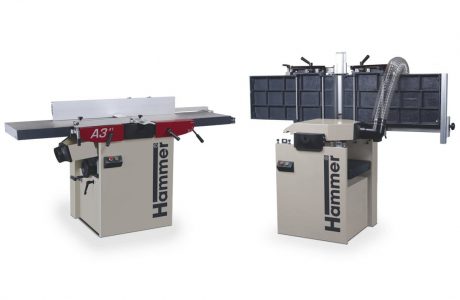
In this article, we will take a look at all the different jointers, planers and jointer planer combo machines made by Hammer. Hammer is a brand known for its excellent build quality and relatively affordable price. Their machines are made in Austria, just like the rest of the machines from the Felder Group.
There are five different machines in the Hammer A3 series — three combination machines, and two single-function machines. The A3 26, A3 31, and A3 41 are jointer planer combo machines. The number in their name stands for the maximum jointing width they can handle.
The A3 41A and A3 41D are basically the A3 41, but split into two separate machines. The A3 41A is purely a jointer, and the A3 41D is solely a thickness planer. The A stands for Abrichthobel, German for jointer, and D stands for Dickenhobel, German for thickness planer.
In this short guide I’ll compare the A3 26 and the A3 31, which are more aimed at hobbyists and enthusiasts, and the A3 41 and the A3 41A and 41D, which are more for semi-professionals and professional woodworkers.
Before comparing the different machines, let’s first take a short look at the standard features and options.
The jointer and planer tables are made from cast iron, making them heavy, solid, and likely to stay straight. In the case of the jointer-planer combinations, the jointer tables can swing upwards simultaneously. Hammer also added a small hinge that makes sure that the jointer tables can’t fall down (great for people who don’t want their fingers to be smashed by massive cast iron tables).
The height adjustment for the jointer tables works with a lever, which lets you quickly and easily change the height, and is secured by a simple handle. The planer table can be finely adjusted with a hand wheel. The downside of this focus on precision is that it can take quite long to move it all the way up or down.
TIP: Mick Simon on Youtube found a smart DIY way to raise and lower the tables with a drill, which everyone can make themselves, so it shouldn’t be a major problem.
The blade guard and the fence for the jointer are made from aluminium and generally seem a bit flimsy compared to the solid quality of the rest of the machine. It seems to work well enough though, and is only really a minor issue.
Two optional upgrades are a mortiser, which can be added to the side of the machine, and a wheel base. The wheel base is the same for most Hammer machines, including for example their table saws. Two wheels are attached to the machine itself, and a lifting bar can then be used to add two more wheels and easily move the machine around, regardless of its weight.
In their base form all A3 machines come with 3-knife, self-adjusting, quick-change blades, which is already a major upgrade over a standard cutter block. In the case of a standard cutter block, you will have to spend significant time setting up the blades correctly each time you get them sharpened.
Each machine can also be upgraded with a so-called Silent-Power cutter block, which is Hammer and Felder’s trade name for their spiral cutter block. A spiral cutter block has many separate carbide-tipped blades following a spiral form, instead of a blade across the entire length of the cutter block.
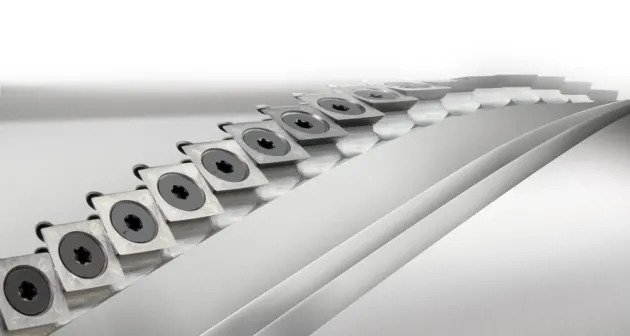
There are multiple advantages to spiral cutters. Not only do they give somewhat better planing and jointing results, they are also more convenient to use. Because they are many separate blades, in case you damage one of them, you will only need to change one, instead of the entire blade. Each blade is attached with a screw and has four sharp sides. When the blade gets dull, you simply unscrew it and turn it 90 degrees.
As the name suggests, Hammer and Felder also claim that the Silent Power cutter block makes less noise. In this video, they show the difference in sounds between the standard and Silent Power blades. The video shows a difference of more than 10dB between the two machines in use. How scientific and accurate this test is, is of course questionable, but you should notice a reasonable decrease in noise in any case.
The cutters are the same size for all machines, and the larger the machine, the more cutters there are on the cutter block. For example, the A3 26 has 37 cutters, while the A3 41 has 62 cutters.
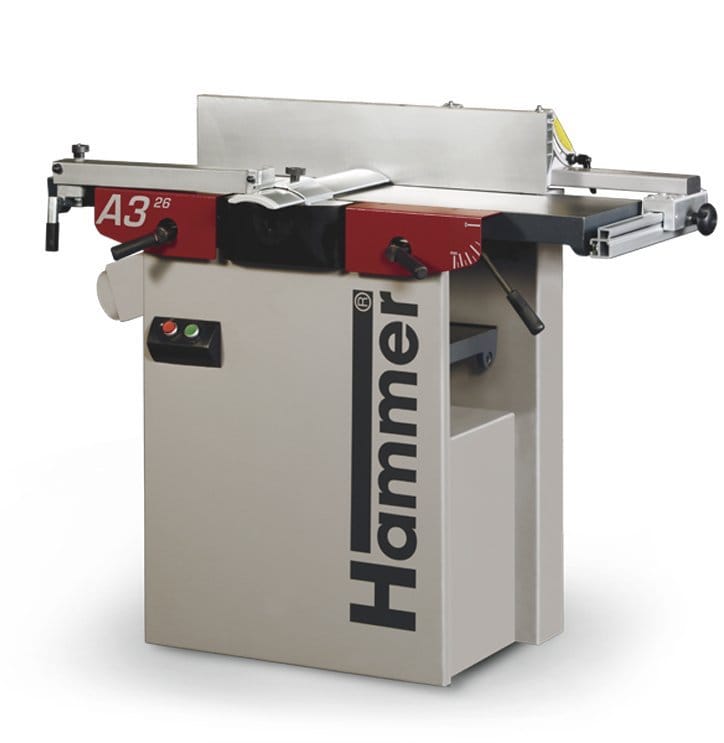
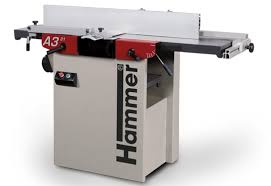
The Hammer A3 26 is the smallest of the jointer planers, and also the only one to only exist in a 230V version. This makes clear that it is aimed purely at the hobbyist, and not professionals who tend to use 400V machines.
There are a few differences between the A3 26 and A3 31. First of all, the A3 31 is slightly larger, with 310 mm jointing width, versus 260 mm. The maximum workpiece height for both machines is identical (225 mm). Whether 260mm is enough depends purely on your experience and needs. You’ll have to consider how often you plane boards wider than that.
The A3 31 also has longer tables and a longer fence. The tables are about 300 mm longer, and the fence about 350mm longer. This makes it quite a significant upgrade. Whereas the A3 26’s tables are comparable to most smaller hobbyist-grade machines, the A3 31’s tables are quite a bit larger.
The biggest difference between the two is the power of the motor. The A3 31 has almost twice the amount of power (3000 vs 1600W), meaning it will be able to handle tougher woods and boards with difficult grains with more ease, and is able to take bigger cuts per pass. 1600W is relatively weak. For example, the Metabo HC 260, which is a much smaller and mobile machine has a 2200W motor in its standard configuration.
The question is whether it is worth the upgrade from the smaller A3 26 to the more powerful and bigger A3 31. The A3 31 is only about 20% more expensive, and has multiple significant upgrades. Since you are already spending quite a lot of money in the first place, we would suggest seriously considering the upgrade, because we think the A3 31 gives quite a lot more value for money.
It would be a bit of a shame to get the A3 26, and after a few months in use realize that although you like the build quality, you would really have preferred the extra power and size. Then again, if you only have enough room or budget for the A3 26, you can’t really go wrong with that either.
Should you then also consider to upgrade to the Hammer A3 41? That is quite a different question, because it costs about 40-45% more and the A3 31 is already large enough for most serious hobbyists. We would only recommend that if you really need the extra capacity.
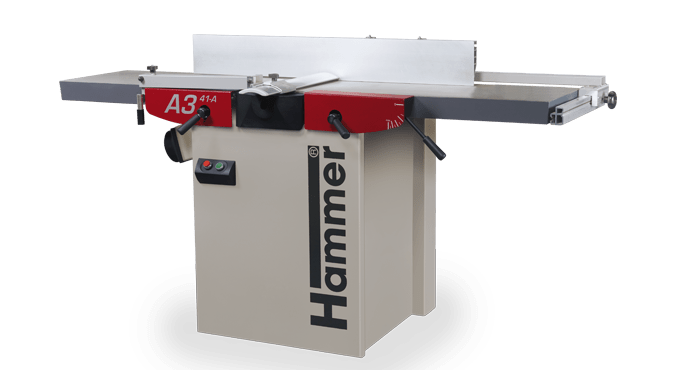
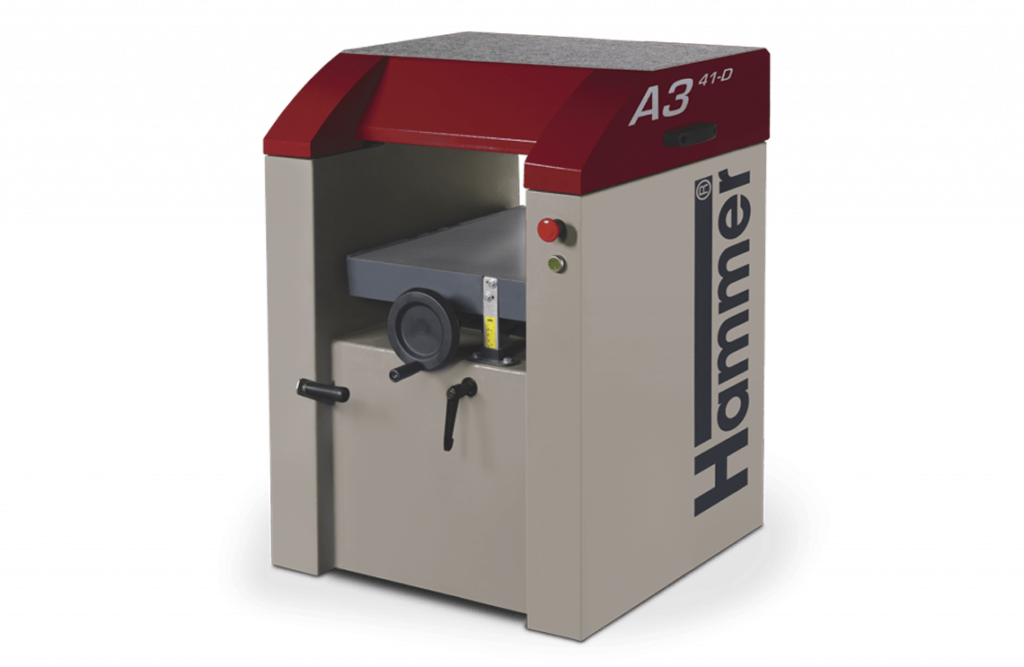
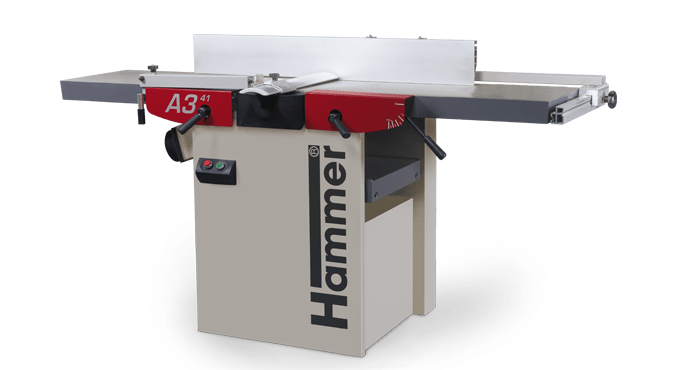
The Hammer A3 41 is the largest of the jointer planer combo machines, and quite a bit more expensive too (40-50% more than the A3 31). It is aimed more at semi-professionals and professionals than hobbyists.
These are people who often work in a production environment and want to use their machines as efficiently as possible. The downside of a combination machine is that you need to spend time to switch functions. If you use the machine all day, then a few minutes spent switching will add up to a lot of time over a whole day.
That is why some people prefer to have two separate machines instead of a combination machine. In the case of the A3 41, there are two separate machines available: the A3 41A jointer, and the A3 41D planer.
These are essentially the same machine, but split into two — their specifications are nearly identical. The biggest downside is their cost — together they are 40 to 50% more expensive than the A3 41 alone. Whether it makes sense to buy the separate machines will depend on your business setting. Ask yourself: Will the time saved from not having to switch between modes save you enough money to justify the price increase?
Check out the video by Bent’s Woodworking below. He goes into detail why he picked the A3 41 Jointer Planer over a separate jointer and planer.
We hope you found this guide helpful. If you have any feedback or tips about these Hammer jointer planers, please share them in the comments below. Your info can really help fellow woodworkers!
© Machine Atlas 2025
Need a jointer/ planner. Thanks
If you had room for one more dedicated machine, in addition to this one, would it be a planer or a jointer? What size would it be?
I’ve been trying to buy the jointer planer and a tablesaw and asked to be contacted by text or email but haven’t heard back in a month. I guess they don’t want my business. I really wanted to try this brand but is this a sign?
Hi Donna, which country are you in? Here in Europe I’ve found the Felder/Hammer sales reps quite responsive. But this may vary depending on your country. Try giving them a call?
Rob